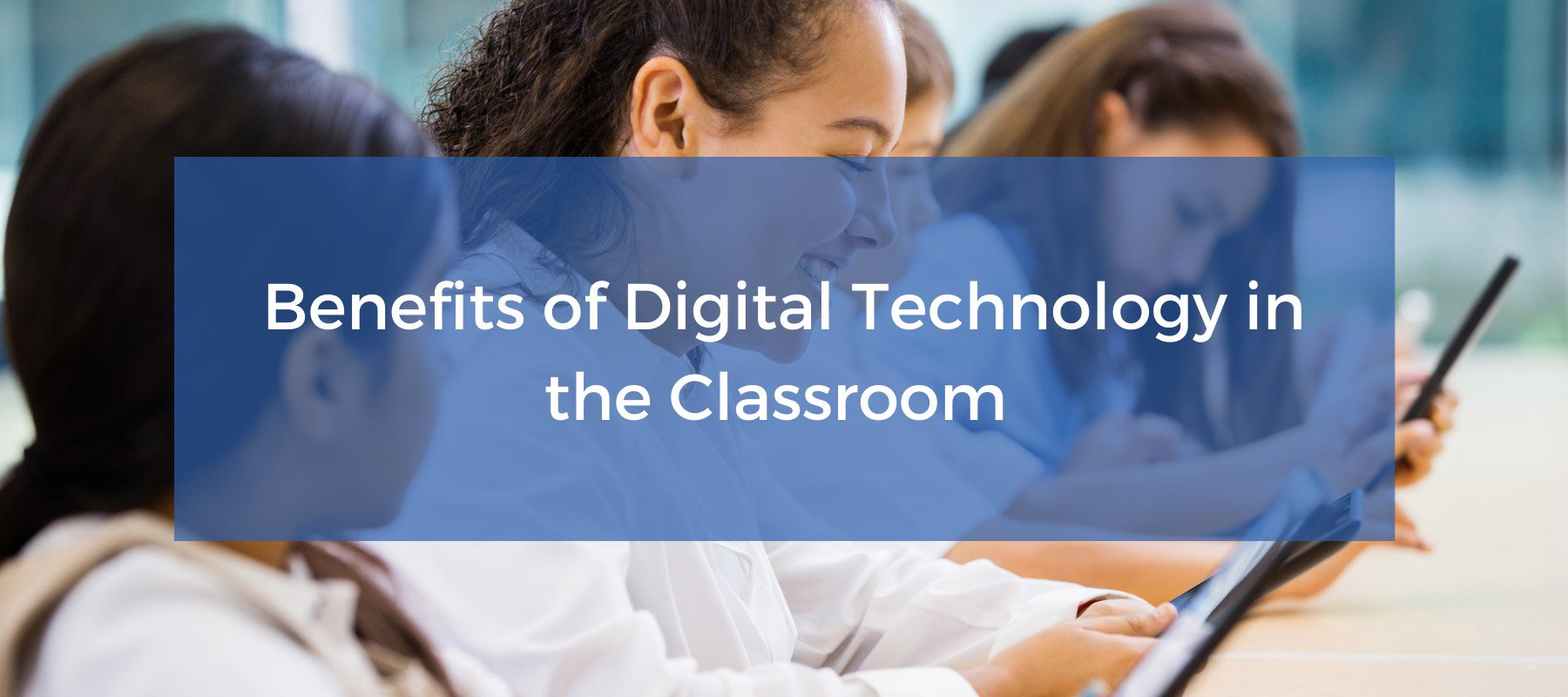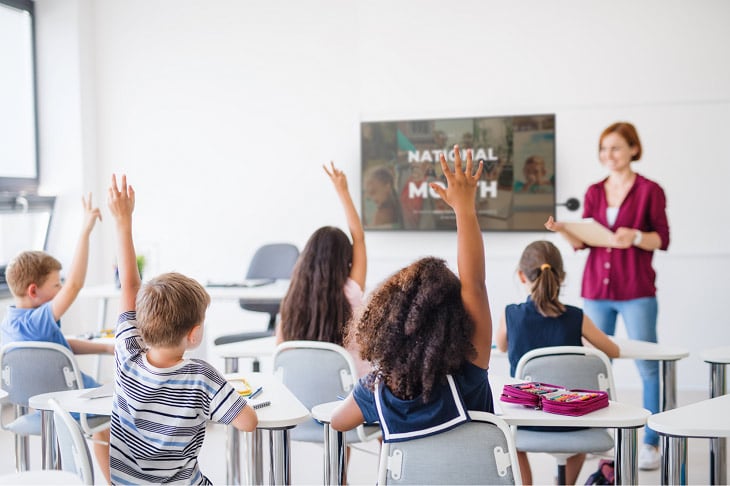
Benefits of Digital Technology in the Classroom
With 95 percent of teachers using technology in the classroom, digital teaching methods are becoming increasingly popular. Gone are the days of chalkboards, worksheet assignments, and rote learning. Advocates say new technologies provide a wealth of benefits to student learning; critics say they are a distraction. Do the benefits outweigh the possible downside? Let's take a look.
What are the benefits of classroom technology?
Here are some of the ways educational technology improves the learning experience for both students and teachers:
For Students
Technology enables educators to accommodate the three main learning styles: visual, auditory, and kinesthetic where traditional techniques may fall short. Here are a few examples:
Visual Learning:
Using PowerPoint slides (within Google Classroom) helps outline key points with pictures and diagrams. YouTube videos with directions on complex subjects and 'walk-throughs' help visual learners focus and understand the material better.
Auditory Learners:
Zoom and Google Meet in an online classroom environment allow auditory learners to listen and connect with their peers and teachers while developing their conversational skills. Audiobooks and reading applications on tablets such as Me Books provide younger students with the ability to listen to a voice recording or record their voices to practice reading—this digital technology helps new readers sound new words.
Kinesthetic Learning:
PHeT Interactive Simulations, operated by the University of Colorado Boulder, is a website that offers educational games for students learning math and science. For kinesthetic learners, playing these games develops skills such as building an atom or performing an online experiment on solubility.
Learn more: Is Google for Education Right for Your School?
Technology can enhance collaboration and participation and promote inclusivity online, at home, and in school. Hashtags, group chats, and event pages create online forums for student voices to a global audience - asking questions and brainstorming ideas beyond the boundaries of geography.
Enabling students to collaborate outside their immediate circle of friends creates an opportunity for them to share knowledge, ideas, and learning opportunities with people they might not have had the chance to otherwise.
Digital literacy is essential for college and career readiness. By integrating technology into the classroom, teachers can prepare students for the complex problems in the workforce and how to solve them. Chances are if a student or teacher is experiencing an issue, someone else has decided to build a company or team to fix it using technology. EdTech prepares students to collaborate with peers in school and the workforce.

For Teachers
Teachers can create a more active learning and engaging environment using technology. Online polling or Quizlets are examples. Technology also creates a dynamic classroom environment where textbooks become digitized with embedded links and QR codes to review and test course materials.
Being well-versed in technology can support teachers in adding new tools. For example software for specific projects or creating flipped classrooms. In this environment, students can watch pre-recorded lectures as homework, and arrive at class ready to discuss materials and content.
New technologies can ease teacher workload by automating repetitive tasks and parts of the teaching process. There are tools for creating and grading tests. Most will upload the results to a database, where it is easy to verify each student's performance.
Communicating with students and families is time-consuming. Social media and texting allow teachers to reach the entire community and create a one-on-one dialogue with each student and each parent. Automoto.io helps sync calendars from online spreadsheets, posting to social media accounts, and organizing contact information.
Google Home and Alexa from Amazon aren't only for playing music. In the classroom, they can help with critical thinking skills and time management with timers, reminders, and voice-activated to-do lists. Sharing information between teachers and parents requires practice and organization.
Airtame provides teachers with the ability to wirelessly present digital signage from any device, for all screens, and all-in-one cloud management functionalities. When a teacher is no longer sharing their screen to the Airtame device, the school can show Rise Vision digital signage content on it to keep the school informed with notices, emergency alerts, and posters.
 What are the downsides of technology in the classroom?
What are the downsides of technology in the classroom?
Technology certainly has its benefits in the classroom. Though educators love adopting newer ways to increase efficiency, these can also have a downside.
Smartphones can be a distraction. Nearly half the time that students are using their smartphones in class, they are focusing on texting, tweeting, or using social media rather than the lesson. To counter this, teachers need to take more time learning how to effectively command.
No technology can replace or even substitute for teachers. Teachers love their profession and have the skills and education to help progress student's into the next chapter of their lives. Technology isn't the solution to all classroom problems; it is an 'add-on' to enhance the learning experience.
New digital technologies in classrooms require management and training. Teachers must be effective in classroom environments and online using screen and tech platforms. Studies show that three-quarters of teachers say the internet and other digital tools have dramatically increased the range of content and skills they must be knowledgeable about, with nearly half saying it has increased their workload.
There is also a case to be made that technology will increase the achievement gap. Classroom technologies, like any technology, costs money. When implementing for one school, a small device may need to be installed for (on average) 20 or more classrooms. Some school boards in rural districts do not have the same funding as urban ones, affecting students' ability to learn.
How many schools and teachers use technology in the classroom?
As of 2008, all U.S. public K-12 schools had one or more computers for instructional purposes. 97% of K-12 public school teachers reported having one or more computers in their classroom, and 69% said that they or their students often or sometimes used computers during class time. In addition to computers, the majority of teachers reported these technological devices in their classrooms every day:
- LCD Displays or digital light processing projectors (84%)
- Digital cameras (78%)
- Interactive whiteboards (51%)
K-12 teachers report that 47% of their students had regular access to mobile devices in their classrooms. When it came to which devices students used for schoolwork during the school day:
- Use of their own devices (58%)
- School laptops (32%)
- School Chromebooks (16%)
- School tablets (14%)
In total, 13% of high school and 21% of middle school students discuss having no access to computers or mobile devices.

Is digital technology essential in the classroom?
Policymakers and researchers found many potential benefits of online learning, including increased access to resources, personalizing learning, and assisting struggling students. Findings from existing research studies suggest modest positive effects of technology on student learning.
One research study found that one-to-one laptop programs had a modest effect on a student's overall academic achievement in mathematics and science. Some studies determined that technology's potential to improve student achievement is dependent on its path to instruction.
How does your school integrate technology into learning for students and teachers? Do you see the benefits? Let us know!
To find out about how Rise Vision can help your digital technology needs attend our weekly webinar.
More From Our Blog
-

Screen Sharing for Workplace Collaboration | Rise Vision
Screen-sharing technology has transformed how teams communicate and work together in real-time, regardless of their location. It can make presentations more engaging, support remote work, and speed[…]
Read More -

How to Use PowerPoint for Digital Signage
To create stunning, attention-grabbing, and effective digital signage content, you need the help of content creation and presentation tools. One of the most popular is Microsoft PowerPoint, owing to[…]
Read More -

120 Digital Signage Content Ideas
So…. you decided you would invest in some digital signage software and you need some ideas for ways you can make it stand out. This article is your go-to source for the best digital signage content[…]
Read More
Keep Your Displays Interesting – Pick New Templates Every Week!
Every week, we send template recommendations that will make you look great and improve your audience experience. And the best part, they save up to 16 hours of content creation time every week!
12,300+ Organizations Trust Rise Vision, You Can Too
Schedule a Free Demo
You deserve the #1 all-in-one platform for digital signage, screen sharing, and emergency alerts.



































